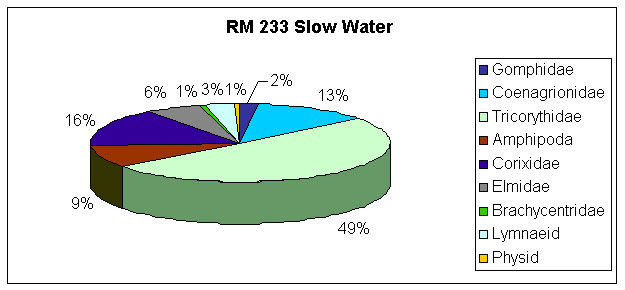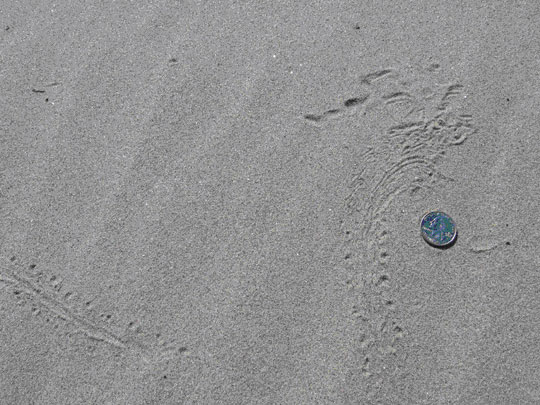GEOMORPHIC DESCRIPTION
Mile 233 lies in Lodore Canyon, a debris fan dominated canyon confined by Precambrian quartzite of the Uinta Mountain Group. A large debris fan on river left and a smaller debris fan on river right have constricted the channel, creating a fan-eddy complex with rapids adjacent to the fans. Ponded flow upstream has created sandy channel margin deposits. Both separation and reattachment sandbars have formed downstream where the flow separated and an eddy formed. Further downstream, an expansion bar consisting of both cobbles and boulders has formed. Rabbit brush, box elder, and juniper were observed on the larger debris fan. Post-dam flows have created active floodplains on the upstream side of each debris fan, with a small gravel floodplain river right and a larger floodplain consisting of cobbles and sand along river left. The separation and reattachment sandbars are also part of the active post-dam floodplain, and at the time of the survey the reattachment bar was partially inundated, forming backwater habitat. These sandbars transition into an intermediate bench consisting of cobbles and sand, and vegetated with tamarisk. Beyond the intermediate bench lies a narrow pre-dam terrace, adjacent to bedrock and inhabited by box elders. Talus deposits line the channel margin in the remaining regions.



RIPARIAN VEGETATION

At river mile 233, it appeared that tamarisk excavation had also been attempted based on the presence of several thick stumps. Three transects were constructed in various areas of the debris-fan to illustrate the presence of different species at different elevations. The first transect spanned the region of the greatest elevation change (see geomorphology cross-section). Geomorphic surfaces of transect 1 included a post-dam terrace and a pre-dam terrace. The post-dam terrace on transect 1 was occupied by only tamarisk. With a sharp increase in elevation, vegetation changed to primarily rabbitbrush and box elder on the pre-dam surface (see geomorphology cross-section). Sediment spanned by transect 1 was very course, and did not employ a dense vegetation cover. In this region large Utah juniper, prominent in upland terrestrial environments, were seen on the debris-fan. Though not represented by the transect data, box elders were seen upstream on the debris-fan at elevations low enough to possibly be the intermediate bench. This may be possible because of recent droughts as well as regulated flows. Transect 2 was located further downstream and was geomorphically defined by all three terrace surfaces (see geomorphology map). The post-dam terrace was occupied by marsh vegetation and tamarisk (Fig. 1). On the intermediate bench, signs of tamarisk removal were observed. This terrace was primarily occupied by grasses and dried marsh vegetation, suggesting that inundation of this surface does occur. The width of the pre-dam terrace was small compared to transect 1 (see geomorphology cross-section). Box elder and Utah juniper were also seen here. Transect 3 was measured between the two variable surfaces (see geomorphology map). The post-dam terrace was a non-vegetated sandbar (see geomorphology cross-section). The intermediate bench was dominated by marsh vegetation while the pre-dam surface was occupied by rabbitbrush, box elder and Utah juniper (Fig. 1).
WATER QUALITY
Temperature was lower in the backwater at this site probably because the sun had not yet hit the water. Turbidity in the backwater was higher because disturbance from seining had previously occurred. % Dissolved Oxygen was lower in the backwater probably because plants had not yet begun to photosynthesize or due to lack of plant growth.

|
Date |
Time |
Location |
pH |
Temperature (°C) |
Specific Conductivity (mS/cm) |
Turbidity (NTU) |
% Dissolved Oxygen |
Air Temp (°C) |
|
6/18 |
9:45 AM |
Green River main channel |
7.15 |
17.00 |
0.600 |
10.6 |
86.1 |
|
|
6/18 |
10:25 AM |
Green River eddy |
7.15 |
17.02 |
0.600 |
12.0 |
85.1 |
14.7 |
|
6/18 |
10:40 AM |
Backwater after seining |
7.15 |
16.04 |
0.618 |
|
66.8 |
26.0 |
FISH
Seine Collection Data:

|
Species |
FL (mm) |
N |
|
Mountain Whitefish |
56 |
1 |
|
Speckled Dace |
27-50 |
6 |
|
Mottled Sculpin (Larvae) |
8-10 |
630 |
General Comments:
As water temperature and turbidity continued to increase with our distance from the dam, there was a notable decrease in large salmonids. Angling efforts seemed to show an apparent shift in dominance from brown to rainbow trout. Smallmouth bass began to appear as we neared the Yampa confluence, and a large (375mm) individual was excellent fare for dinner.

AQUATIC INVERTEBRATES
Riffle habitat and slow-flowing backwater habitat were sampled at this site. Substrate size and aquatic vegetation cover were estimated.
Habitat A - Slow moving backwater
Substrate: 30% silt, 70% sand
Vegetation: ~10 % cover composed of Chara, Cladophora, and Sago pondweed.
Diversity: 1.5

Habitat B - Riffle
Substrate: 20% sand, 80% boulder
Vegetation: ~60% cover composed of bryophytes and Cladophora.
Diversity: 1.2

Comments: Gomphidae larvae (club-tailed dragonflies) were found under rocks in slightly different habitat than the rest of the slow-water habitat.
BIRDS, MAMMALS, REPTILES, AND AMPHIBIANS
We surveyed this sight for an hour in the mid-morning with weather conditions of no wind and less than 25% cloud cover. This site is a sandbar within the Canyon of Lodore, and contains junipers, shrubby vegetation, and canyon ledges. Birds were identified by visual sightings, or song or track recognition. Lizards and mammals were identified only by tracks.
This is the only site where lizard tracks were present, but we were unable to identify them to species (Fig. 1). We also observed a nesting western kingbird in the canyon ledges. The female was foraging for insects over the river and removing fecal matter from the nest containing three young.
|
Common Name |
Scientific Name |
# |
ID |
Location |
|
Black-throated gray warbler |
Dendroica nigrescens |
1 |
sound |
junipers |
|
Canada goose |
Branta canadensis |
1 |
tracks/scat |
bank |
|
Canyon wren |
Catherpes mexicanus |
2 |
sound |
canyon ledge |
|
Great blue heron |
Ardea herodias |
1 |
tracks |
edge |
|
Spotted sandpiper |
Actitis macularia |
2 |
sight |
edge |
|
Tree swallow |
Tachycineta bicolor |
2 |
sight |
air |
|
Western kingbird |
Tyrannus verticalis |
4 |
sight |
canyon ledge |
|
Mule deer |
Odocoileus hemionus |
2 |
tracks |
edge |
|
Olive-backed pocket mouse or Great Basin pocket mouse |
Perognathus fasciatus or P. parvus |
1 |
tracks |
bank |
|
Unidentified lizard |
unknown |
1 |
tracks |
bank |

